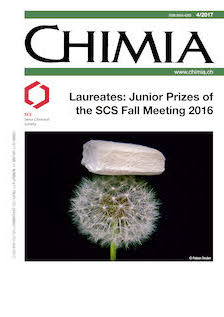State-of-the-art Nanofabrication in Catalysis
DOI:
https://doi.org/10.2533/chimia.2017.160Keywords:
Electrocatalysis, Heterogeneous catalysis, Lithography, Nanoparticles, Surface scienceAbstract
We present recent developments in top–down nanofabrication that have found application in catalysis research. To unravel the complexity of catalytic systems, the design and use of models with control of size, morphology, shape and inter-particle distances is a necessity. The study of well-defined and ordered nanoparticles on a support contributes to the understanding of complex phenomena that govern reactions in heterogeneous and electro-catalysis. We review the strengths and limitations of different nanolithography methods such as electron beam lithography (EBL), photolithography, extreme ultraviolet (EUV) lithography and colloidal lithography for the creation of such highly tunable catalytic model systems and their applications in catalysis. Innovative strategies have enabled particle sizes reaching dimensions below 10 nm. It is now possible to create pairs of particles with distance controlled with an extremely high precision in the order of one nanometer. We discuss our approach to study these model systems at the single-particle level using X-ray absorption spectroscopy and show new ways to fabricate arrays of single nanoparticles or nanoparticles in pairs over a large area using EBL and EUV-achromatic Talbot lithography. These advancements have provided new insights into the active sites in metal catalysts and enhanced the understanding of the role of inter-particle interactions and catalyst supports, such as in the phenomenon of hydrogen spillover. We present a perspective on future directions for employing top–down nanofabrication in heterogeneous and electrocatalysis. The rapid development in nanofabrication and characterization methods will continue to have an impact on understanding of complex catalytic processes.Downloads
Published
2017-04-26
Issue
Section
Scientific Articles
License
Copyright (c) 2017 Swiss Chemical Society

This work is licensed under a Creative Commons Attribution-NonCommercial 4.0 International License.
How to Cite
[1]
Chimia 2017, 71, 160, DOI: 10.2533/chimia.2017.160.







